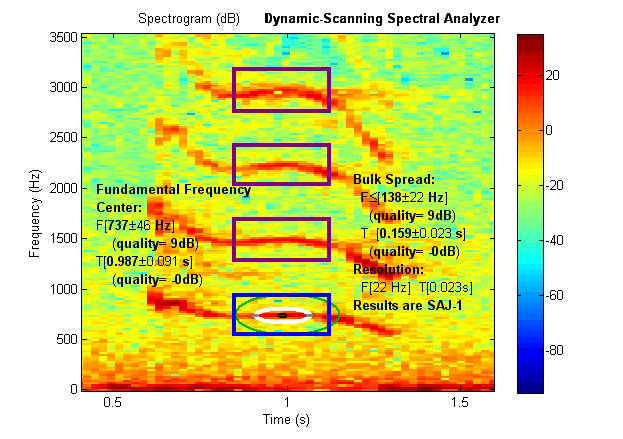Dynamic-Scanning Spectral Analyzer
Freely-accessible tool for researchers. Make your results more consistent!
Improved Version V0.62 is Here!
Download Here - Version 0.62 for Windows XP. [less than 1 MB]
New users also need the MATLAB runtime libraries (save 146MB file, then run) unless you already have Matlab R2007a for Windows XP.
Please send an email to  ==> I will notify you when there is an improvement.
==> I will notify you when there is an improvement.

Abstract from IBAC 2009Ryan Janzen, Laura BoltUniversity of Toronto Many researchers base their findings upon acoustic features of vocalisms, found by visually inspecting ("eyeballing") spectrograms, or by reading off numbers from software tools without knowing to what signal-processing standard those numbers were determined. Without using a consistent measuring tape, so to speak, the scientific process of reproducing and confirming others' results becomes more problemmatic, and measurement itself becomes open to bias. We present an improved signal-processing algorithm to more accurately determine spectral parameters from vocalisms, in an effort to achieve more precise, reliable and consistent results. A dynamic spectral scanning algorithm is proposed to computationally scan a spectrogram and precisely locate the frequency and/or time of a sound, instead of approximately locating it by eye. This method takes advantage of higher harmonics in order to determine the fundamental frequency more precisely. The algorithm, designed by the first author, was applied to ring-tailed lemur (Lemur catta) vocalisms by the second author. Results are presented in comparison to results from traditional analysis techniques. New vocal measurement features become possible, as a result of the new method. For example, several novel variants of maximum/minimum fundamental frequency, peak frequency, and bandwidth, become available to the researcher. Novel vocal features provide researchers with new possibilities in linking vocalisms to behaviour. A freely-accessible tool was created to allow researchers to use this algorithm with their own recordings. It is available for download at: http://individual.utoronto.ca/janzen/spectral |
Enclosed Spectrogram Moments for the Measurement of Non-Stationary SignalsRyan Janzen, University of TorontoAn algorithm was devised for translating information on a spectrogram into simple yet robust measurements for scientific analysis. The algorithm works on a strategy of accepting a region-of-interest on the spectrogram, isolating harmonics within enclosures, dealing with nonstationary noise separately for each harmonic, computing joint time-frequency moments, determining measurement uncertainties, and consolidating the information from each of the harmonics. The algorithm was found to pinpoint spectral/temporal information on the fundamental of a harmonic signal, consistently within a plus-or-minus error readout that the algorithm generated. This work features a generalized algorithm, the next generation beyond the above work which was designed specifically for primate vocalizations. (IEEE publication to appear on IEEE Xplore, from CCECE2010)
|